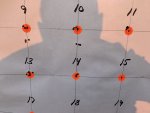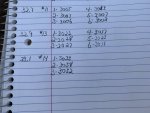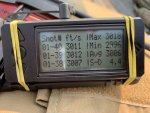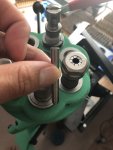I was trying to stay with you, but your repeating this statement makes me think your motives are not aligned with what most are doing. The people that are only interested in capping brass to send a piece of lead down the pipe and say 'look I hit a 100 yard target' are not interested in figuring stuff out. If you are only interested in seeing if you can get a neck to outlive the primer pocket without annealing, well you are wasting your time as that has been done and most don't give a care. It may very well prevent you from understanding why annealing matters.
If your goal is precision at 100 without annealing, and shoot until the primer pocket blows, then do what some of the old timers did - run you case mouth wide so it has minimal tension, charge the case, start the bullet and leave it long, then finish seating it by clambering the round. It works, and works well, but you need to turn the neck and have a match chamber otherwise you won't get a good seal thus making a mess of the chamber and possibly not burning all the powder. You can't do this with LR rounds as you need to build enough pressure to carry that bullet to where the BC is kicking in, meaning you need velocity. You don't need any of that stuff for 100 yards.
A round that is good at 100 yards says nothing about what it is going to do at 1000 yards. Distance requires pressure - this is THE reason whey K&M has 2 different force packs for their arbor press; the low forcepack is for benchrest, not LR. I run into guys that mainly shoot out to 300 and they say using an expander is the bomb. Yeah, sure, whatever. Then they go somewhere that they can shoot to 1k and their stuff don't work. So then the read or ask around, ditch the expander, and then they get pressure problems because the charge that worked with the lose neck does not work with more tension.
If you are only shooting 100 and are concerned about brass life just go build a killer 22LR and be done with it. You are going to save a bunch of money and have more time to shoot. If you decide to make this about maintaining precision beyond 100 yards without having to adjust/redevelop loads while not annealing, then maybe I will read on as I am not aware that anyone has solved that.
First and foremost, I got the verification that no annealing was done to the 5 rounds fired 32 times. Post was updated to note this.
Honestly, I repeated the same shit over and over because I was basically walking people through my thought process. (IE, I didn't think 100% of the people were capable of making connections between points, so I did my info/details barney style just like what I did here.)
Clarifying again, I used the data from 32 firings because it was
1.) data from an outside test
2.) 5 rounds fired 32 times showed that with no annealing,
3.) The group size was an added bonus that showed the brass was still usable at firing 32 AND had usable accuracy.
If I had followed up with MY data first? I am pretty sure I would have gotten much more nitpicking. Now, as of this Saturday 9/7/19, the 50 rounds I set aside for practice have had 9x reloads, with groups still 3/4moa or less, with a velocity of 2821, SD of 7 at a density altitude of 2660.
As for my practice regiment,
I'll usually put 5 rounds for use through the chrono to see where I am at, and 5 rounds at 100 yards to see how I'll be shooting that day, then the remaining 40 rounds are used for distances from 500 to 1100 yards. If I had known I'd have to prove anything, I would have taken results on paper targets. I'll be sure to do so next time I go training.) I then go back to 100-300 and practice shooting group exercises in the prone/modified prone on a 22lr bolt until I get bored.
My reloading process?
- Deprime via frankford arsenal hand deprimer
- Wash in wet tumbler (15 minutes, with lemishine+dawn) + dry in dehydrator (30 mins)
- Resize via Redding FL die. (Redding T7, not a bushing die, no decapping rod/expander ball, imperial sizing die wax)
- Expand neck with 21st Century expander mandrel + die (Used with Imperial Dry neck lube)
- Prime via RCBS hand primer
- Weigh powder via pharmaceutical scale +/- 0.02 grains (0.01 Grain accuracy)
- Seat bullet via Redding Competition seater die
In between every process, cases are gauged to ensure +/- 0.0005 consistency. The entire process takes around 2 hours for 50 rounds from cleaning to loaded ammo. In comparison to when I started, I had an SD of 7 during 1x. My best SD is 3 after making sure powder charge was exact and all case dimensions were the same, at the cost of 3 hours per 50 rounds start to finish. To add more info, I have 300 pieces of Peterson brass. 250 pieces have an internal volume deviation of +/- 1.00 grains of water, fired 5x, and primarily used for competition. The 50 that I use to practice have an I.V. SD of 10 grains of water. Even with the volume difference, I've still been able to keep a MV and SD that is predictable.
With
MY results, I haven't a need for anything to improve what I have. (For $400+, I can just buy 500 pieces of new brass rather than add a process that adds more time on the reloading bench.) With the understanding of the articles and papers, the argument that annealing has too small of a gain vs too high of an investment in is pretty strong. (
I haven't even brought up Litz's findings, but do want to make it known that he did come to a similar conclusion.)
Without clear/direct empirical evidence, assumptions are just assumptions, hence is why I want to try annealing. I have new brass and am building an experimental process to validate the effects of annealing. Honestly, I could probably use most of the hide's thickheaded posters to find weak points in my experiment to develop a pretty inarguable outcome.
However, I suffer from the same problems most on these forums suffer:
I've saved enough money I'm willing to burn on tools and gear, and I am eye fucking an Annie annealer and AMP to test the actual use of a $500 to 1300 machine.






